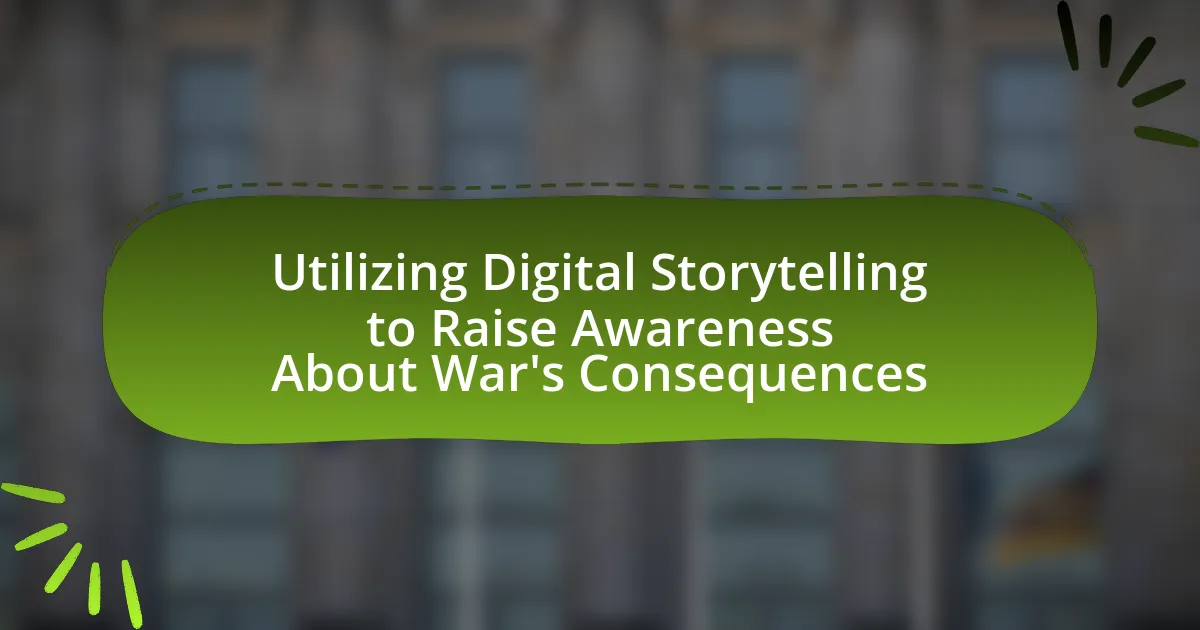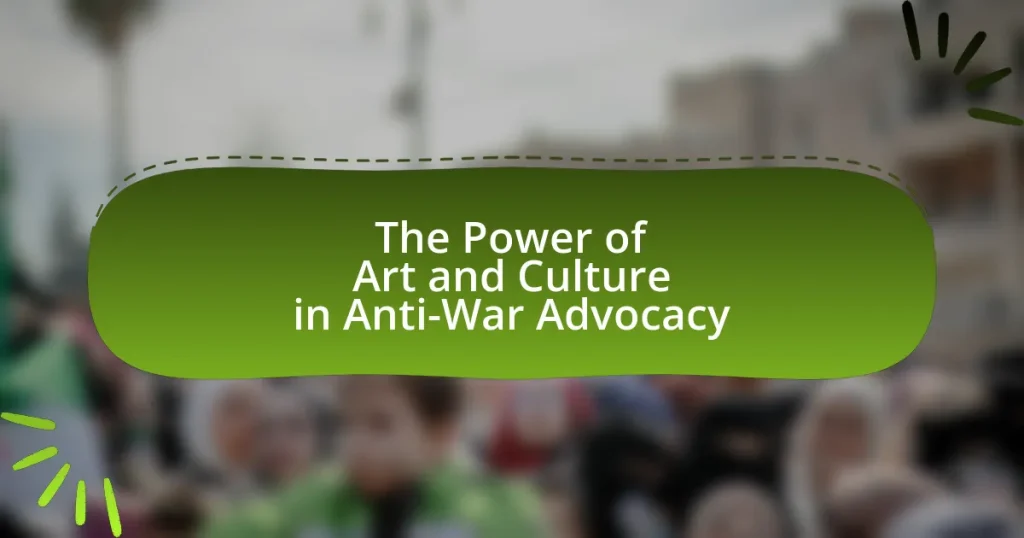Digital storytelling is a powerful method that utilizes multimedia elements to convey narratives, particularly in raising awareness about the consequences of war. This article explores how digital storytelling differs from traditional storytelling, emphasizing its effectiveness in engaging audiences through emotional and immersive experiences. Key elements such as narrative structure, multimedia integration, and audience engagement are discussed, along with the challenges and ethical considerations involved in accurately representing war’s impacts. Additionally, the article highlights best practices for creating impactful digital stories and the role of social media and collaboration in enhancing outreach and effectiveness.
What is Digital Storytelling and Its Role in Raising Awareness About War’s Consequences?
Digital storytelling is the practice of using digital media to create and share narratives, often combining text, images, audio, and video to convey a message. Its role in raising awareness about war’s consequences is significant, as it allows individuals and organizations to present personal stories and experiences that highlight the human impact of conflict. For example, projects like “The War Tapes” have utilized digital storytelling to provide soldiers’ perspectives, illustrating the emotional and psychological toll of war. This approach fosters empathy and understanding among audiences, making the abstract consequences of war more tangible and relatable.
How does digital storytelling differ from traditional storytelling?
Digital storytelling differs from traditional storytelling primarily in its use of technology to enhance narrative delivery. While traditional storytelling relies on oral or written forms, digital storytelling incorporates multimedia elements such as video, audio, and interactive features, allowing for a more immersive experience. For instance, a digital story about war can utilize images, sound effects, and animations to evoke emotions and convey messages more effectively than text alone. This multimedia approach engages audiences in a way that traditional methods may not, making the impact of the story more immediate and visceral.
What are the key elements of digital storytelling?
The key elements of digital storytelling include narrative structure, multimedia elements, interactivity, and audience engagement. Narrative structure provides a coherent storyline that guides the audience through the content, while multimedia elements such as images, videos, and audio enhance the emotional impact and understanding of the story. Interactivity allows users to engage with the content actively, fostering a deeper connection, and audience engagement ensures that the story resonates with viewers, prompting reflection and action. These elements are essential for effectively conveying complex themes, such as the consequences of war, making the storytelling impactful and memorable.
Why is digital storytelling effective in conveying complex issues like war?
Digital storytelling is effective in conveying complex issues like war because it combines visual, auditory, and narrative elements to create an immersive experience that engages audiences emotionally and intellectually. This multimedia approach allows for the presentation of personal stories and diverse perspectives, making abstract concepts more relatable and understandable. For instance, studies have shown that narratives can enhance empathy and retention of information; a report by the National Endowment for the Arts found that storytelling can significantly increase audience engagement and understanding of social issues. By humanizing the experiences of individuals affected by war, digital storytelling fosters a deeper connection and awareness of the consequences of conflict.
What are the primary goals of utilizing digital storytelling in this context?
The primary goals of utilizing digital storytelling in the context of raising awareness about war’s consequences are to engage audiences emotionally, educate them about the realities of conflict, and foster empathy towards affected individuals. Engaging audiences emotionally helps to create a personal connection to the stories being told, making the impact of war more relatable and urgent. Education is achieved by presenting factual narratives that highlight the complexities and human costs of war, thereby informing viewers about its broader implications. Fostering empathy encourages audiences to understand and share the feelings of those impacted by war, which can lead to increased advocacy and support for peace initiatives. These goals are supported by research indicating that emotional engagement in storytelling significantly enhances retention and understanding of complex social issues.
How can digital storytelling influence public perception of war?
Digital storytelling can significantly influence public perception of war by humanizing the experiences of those affected and providing emotional narratives that resonate with audiences. Through personal accounts, visual media, and interactive platforms, digital storytelling allows individuals to connect with the realities of war, fostering empathy and understanding. For instance, studies have shown that narratives featuring personal testimonies from veterans or civilians impacted by conflict can alter perceptions, making the consequences of war more relatable and tangible. Research published in the Journal of Peace Research indicates that exposure to such narratives can lead to increased public support for peace initiatives and a greater awareness of the humanitarian impacts of war.
What emotional responses does digital storytelling aim to evoke?
Digital storytelling aims to evoke emotional responses such as empathy, sadness, and reflection. These emotions are crucial in engaging audiences with the complex realities of war and its consequences. By presenting personal narratives and vivid imagery, digital storytelling fosters a deeper understanding of the human experience affected by conflict, encouraging viewers to connect emotionally with the stories being told. Research indicates that narratives that elicit strong emotional responses can enhance memory retention and motivate action, making digital storytelling an effective tool for raising awareness about the impacts of war.
How Can Digital Storytelling Be Implemented to Raise Awareness About War’s Consequences?
Digital storytelling can be implemented to raise awareness about war’s consequences by creating immersive narratives that combine personal testimonies, visual media, and interactive elements. These narratives can effectively convey the emotional and psychological impacts of war, as evidenced by projects like “StoryCorps,” which collects and shares personal stories from individuals affected by conflict. By utilizing platforms such as social media, websites, and mobile applications, digital storytelling can reach a broader audience, fostering empathy and understanding. Research indicates that engaging storytelling can enhance retention of information and emotional connection, making it a powerful tool for advocacy and education on the realities of war.
What platforms are most effective for digital storytelling about war?
Social media platforms, particularly Facebook, Instagram, and Twitter, are the most effective for digital storytelling about war. These platforms enable real-time sharing of multimedia content, allowing users to engage with stories through images, videos, and live updates. For instance, during the Syrian Civil War, Twitter was instrumental in disseminating information and personal accounts, with hashtags like #Syria trending globally, which increased awareness and mobilized support. Additionally, platforms like YouTube have been used to share documentary-style content that provides in-depth perspectives on war, further enhancing public understanding.
How do social media platforms enhance the reach of digital stories?
Social media platforms enhance the reach of digital stories by providing vast networks for sharing content, allowing stories to be disseminated quickly and widely. These platforms, such as Facebook, Twitter, and Instagram, have billions of active users, which facilitates the viral spread of digital narratives. For instance, a study by the Pew Research Center found that 69% of adults in the U.S. use at least one social media site, indicating a significant audience for digital stories. Additionally, features like hashtags and shares enable users to easily discover and engage with content, further amplifying its visibility. This interconnectedness and ease of sharing make social media a powerful tool for raising awareness about critical issues, including the consequences of war.
What role do websites and blogs play in disseminating these stories?
Websites and blogs serve as critical platforms for disseminating stories about the consequences of war by providing accessible and immediate channels for sharing narratives. These digital mediums enable individuals and organizations to reach a global audience, facilitating the spread of personal accounts, analyses, and multimedia content that highlight the human impact of conflict. For instance, according to a 2020 study by the Pew Research Center, 53% of adults in the U.S. reported getting news from social media, illustrating the significant role these platforms play in shaping public awareness and discourse around war-related issues.
What techniques can be used to create impactful digital stories?
To create impactful digital stories, techniques such as narrative structure, emotional engagement, and multimedia integration are essential. Narrative structure involves crafting a clear beginning, middle, and end to guide the audience through the story, making it easier to follow and understand. Emotional engagement can be achieved by incorporating personal testimonies or relatable characters, which helps the audience connect on a deeper level. Multimedia integration, including visuals, audio, and interactive elements, enhances the storytelling experience and keeps the audience engaged. Research indicates that stories utilizing these techniques can significantly increase retention and empathy among viewers, as evidenced by studies showing that emotional narratives can lead to a 65% increase in message retention compared to non-emotional content.
How can visuals and audio enhance the storytelling experience?
Visuals and audio significantly enhance the storytelling experience by creating a more immersive and emotionally engaging environment for the audience. Visual elements, such as images and videos, provide context and stimulate the viewer’s imagination, making the narrative more relatable and impactful. For instance, studies show that narratives accompanied by relevant visuals can increase retention rates by up to 65% compared to text-only formats. Audio elements, including sound effects and music, evoke emotions and set the tone, further deepening the audience’s connection to the story. Research indicates that sound can influence emotional responses, with specific frequencies and melodies triggering feelings of sadness or hope, which is particularly relevant in narratives about war’s consequences. Together, these sensory components create a multi-dimensional storytelling experience that resonates more profoundly with audiences.
What narrative structures are most effective in conveying war’s consequences?
Non-linear narrative structures are most effective in conveying war’s consequences. These structures allow for the exploration of multiple perspectives and timelines, reflecting the chaotic and fragmented nature of war experiences. For instance, films like “Saving Private Ryan” utilize flashbacks and varying points of view to illustrate the psychological and emotional impacts of conflict on soldiers and civilians alike. Research indicates that non-linear storytelling can enhance emotional engagement, making the audience more receptive to the complex realities of war, as evidenced by studies on narrative transportation in psychology.
What Challenges Are Associated with Digital Storytelling on War’s Consequences?
Digital storytelling on war’s consequences faces several challenges, including the risk of oversimplification, emotional fatigue, and the potential for misinformation. Oversimplification occurs when complex narratives are condensed into brief formats, leading to a loss of critical context and nuance. Emotional fatigue can arise from the repetitive exposure to distressing content, which may desensitize audiences and reduce engagement. Additionally, misinformation can spread easily in digital formats, as unverified stories may circulate widely, undermining the credibility of genuine narratives. These challenges highlight the need for careful curation and responsible storytelling practices to effectively convey the realities of war’s consequences.
What ethical considerations must be taken into account?
Ethical considerations in utilizing digital storytelling to raise awareness about war’s consequences include the need for accuracy, respect for subjects, and the potential impact on audiences. Accuracy is crucial to ensure that the narratives presented do not misrepresent facts or experiences, as misinformation can perpetuate harmful stereotypes or narratives. Respect for subjects involves obtaining informed consent from individuals whose stories are being shared, particularly vulnerable populations affected by war, to honor their dignity and autonomy. Additionally, the potential impact on audiences must be considered, as stories can evoke strong emotional responses and influence public perception, necessitating a responsible approach to storytelling that avoids sensationalism or exploitation of trauma.
How can storytellers ensure accuracy and sensitivity in their narratives?
Storytellers can ensure accuracy and sensitivity in their narratives by conducting thorough research and engaging with affected communities. This approach allows them to gather factual information and personal experiences, which enhances the authenticity of their stories. For instance, utilizing primary sources such as interviews with veterans or civilians impacted by war can provide nuanced perspectives that reflect the complexities of their experiences. Additionally, adhering to ethical storytelling practices, such as obtaining consent and being mindful of cultural sensitivities, further promotes respect and accuracy in representation. Research indicates that narratives grounded in real experiences foster empathy and understanding, making them more impactful in raising awareness about war’s consequences.
What are the potential risks of oversimplifying complex issues?
Oversimplifying complex issues can lead to significant misunderstandings and misinformed decisions. When intricate topics, such as the consequences of war, are reduced to simplistic narratives, critical nuances and diverse perspectives are often lost. This can result in a lack of empathy and awareness regarding the multifaceted nature of human experiences in conflict situations. For instance, research by the International Committee of the Red Cross highlights that oversimplified portrayals of war can diminish public understanding of humanitarian crises, leading to inadequate responses from policymakers and the public. Therefore, the risks include fostering ignorance, perpetuating stereotypes, and hindering effective solutions to complex problems.
How can digital storytellers overcome technical and resource limitations?
Digital storytellers can overcome technical and resource limitations by leveraging accessible tools and platforms that require minimal investment. For instance, many storytelling applications and software, such as Canva and Adobe Spark, offer free or low-cost options that enable creators to produce high-quality content without extensive technical skills. Additionally, utilizing smartphones for video recording and editing can significantly reduce costs while still allowing for impactful storytelling. Research indicates that 85% of people prefer video content over other formats, highlighting the effectiveness of these tools in engaging audiences. By focusing on creativity and narrative rather than expensive equipment, digital storytellers can effectively convey messages about war’s consequences, ensuring their stories reach a wider audience despite resource constraints.
What tools and resources are available for aspiring digital storytellers?
Aspiring digital storytellers can utilize various tools and resources to enhance their storytelling capabilities. Key tools include software like Adobe Creative Suite for video editing and graphic design, platforms such as Canva for creating visual content, and storytelling frameworks like the Hero’s Journey to structure narratives effectively. Additionally, resources such as online courses from platforms like Coursera and Udemy provide valuable training in digital storytelling techniques. According to a report by the Pew Research Center, 73% of educators believe that digital storytelling enhances student engagement, highlighting the effectiveness of these tools in fostering impactful narratives.
How can collaboration enhance the quality of digital storytelling projects?
Collaboration enhances the quality of digital storytelling projects by integrating diverse perspectives and expertise, which leads to richer narratives. When multiple creators contribute their skills—such as writing, visual design, and technical production—the resulting stories become more engaging and multifaceted. Research indicates that collaborative projects often yield higher-quality outcomes; for instance, a study published in the Journal of Creative Behavior found that teams outperform individuals in creative tasks due to the pooling of ideas and resources. This collective effort not only improves the storytelling process but also ensures that the narratives resonate more deeply with audiences, particularly in sensitive topics like the consequences of war.
What are some best practices for creating effective digital stories about war?
To create effective digital stories about war, focus on authenticity, emotional engagement, and factual accuracy. Authenticity ensures that the narratives reflect real experiences, which can be achieved by incorporating firsthand accounts from veterans or civilians affected by conflict. Emotional engagement can be enhanced through compelling visuals and soundscapes that resonate with the audience, making the story more impactful. Factual accuracy is crucial; using verified data and historical context strengthens the narrative’s credibility. For instance, the use of statistics about civilian casualties or displacement can provide a stark backdrop to personal stories, illustrating the broader consequences of war.
How can feedback and audience engagement improve storytelling outcomes?
Feedback and audience engagement can significantly enhance storytelling outcomes by providing insights that refine narrative elements and increase relatability. When creators receive feedback, they can identify which aspects of the story resonate with the audience, allowing for adjustments that improve emotional impact and clarity. For instance, a study by the Pew Research Center found that interactive storytelling, which incorporates audience input, leads to higher viewer retention and satisfaction rates. Engaging the audience through discussions or polls can also foster a sense of community, making the story more compelling and relevant. This iterative process of incorporating feedback ensures that the storytelling evolves to meet audience expectations, ultimately leading to more effective communication of themes, such as the consequences of war.
What strategies can be employed to maintain viewer interest and empathy?
To maintain viewer interest and empathy in digital storytelling about war’s consequences, employing immersive narratives and relatable characters is essential. Immersive narratives engage viewers by placing them in the story, often through techniques like virtual reality or first-person perspectives, which can evoke strong emotional responses. Relatable characters, who reflect real-life experiences and struggles, foster empathy by allowing viewers to connect personally with their journeys. Research indicates that stories featuring emotional arcs and character development significantly enhance viewer engagement and empathy, as demonstrated in studies by the University of California, which found that narratives that evoke emotions can lead to increased understanding and compassion for others’ experiences.



